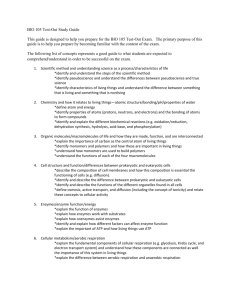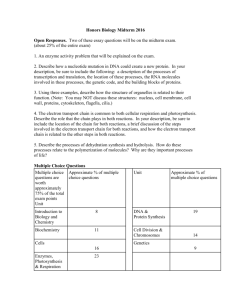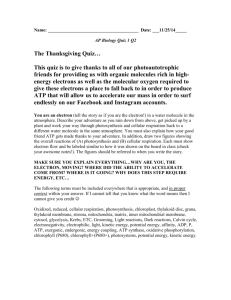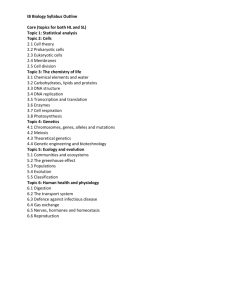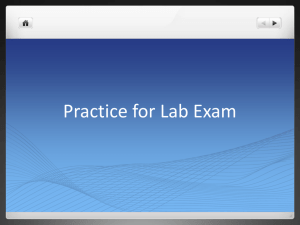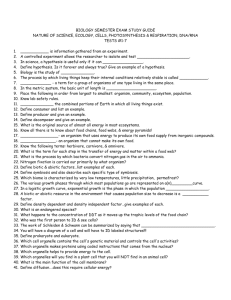Essential Questions
advertisement
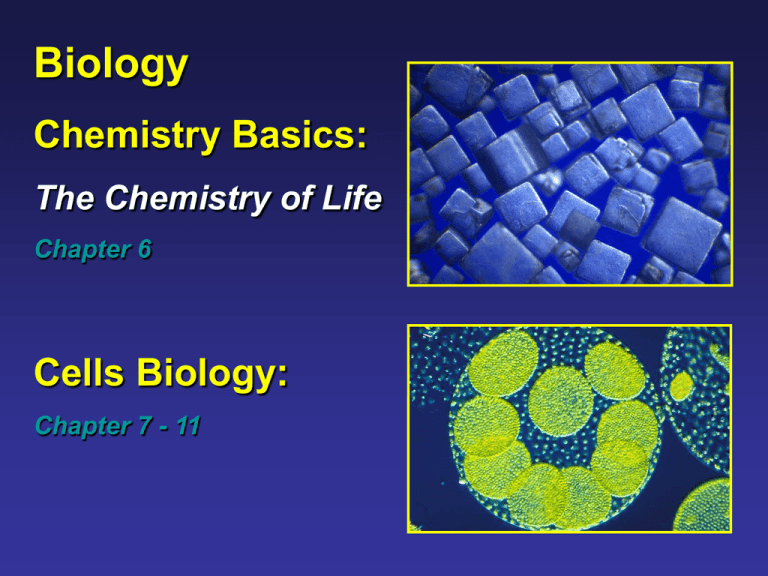
Biology Chemistry Basics: The Chemistry of Life Chapter 6 Cells Biology: Chapter 7 - 11 Biology - Chemistry Topics Essential Questions • Introduction to chemistry • What is matter? • What are the unique properties of water that are necessary for life? • What are organic molecules? • Describe the composition and function of organic molecules. • Water the substance of life • Organic Molecules: composition and function Atoms Subatomic Particles Protons (+) Neutrons (neutral) Electrons (-) Atomic Characteristics Atomic number number of protons Atomic mass protons + neutrons Subatomic particles interaction. Ions Atom or group of atoms with one or more positive (+) or negative (-) electrical charges Atomic Structure Isotopes Two or more forms of a chemical element that have the same number of protons but different mass numbers because they have different numbers of neutrons in their nuclei. Energy Levels and Ionic Bonding Covalent Bonding Chemical Bonds Atoms Matter and Chemical Reactions: Matter Anything that has mass (the amount of material in an object) and takes up space. Elements Chemical, such as hydrogen (H), iron (Fe), sodium (Na), carbon (C), nitrogen (N), or oxygen (O), whose distinctly different atoms serve as the basic building blocks of all matter. Two or more elements combine to form compounds that make up most of the world's matter. Compounds Combination of atoms, or oppositely charged ions, of two or more different elements held together by attractive forces called chemical bonds. Atoms Minute unit made of subatomic particles that is the basic building block of all chemical elements and thus all matter; the smallest unit of an element that can exist and still have the unique characteristics of that element. Ions Atom or group of atoms with one or more positive (+) or negative (-) electrical charges. Molecules Combination of two or more atoms of the same chemical element (such as O2) or different chemical elements (such as H2O) held together by covalent bonds. Chemical Reactions States of Matter Solid Liquid Gas Phases of Matter Characteristics of water: 1. liquid at room temperature 2. universal solvent for polar molecules 3. water molecules are cohesive 4. temperature of water changes slowly 5. high heat of vaporization 6. frozen water is less dense so ice floats How does water make life possible? • Carbon Chemistry (Organic Chemistry) – Make a list of ten ways Carbon chemistry influences our lives. – Modern Marvels –Carbon • Sugar – Make a list of ten ways that the chemistry of sugar influences our lives. – Modern Marvels –Sugar Tests for different types of sugar: Simple Sugars (monosaccharide) – Benedicts Test Positive test – orange or green Complex sugars (starch) – Iodine Test Positive test – blue black Carbon Compounds - Concept Map Building blocks of all life Carbon Compounds include Macromolecules Carbohydrates Lipids Nucleic acids that consist of Sugars and starches Proteins Building Blocks Fats and oils Nucleotides Amino Acids which contain Elements Carbon, hydrogen, oxygen Carbon, hydrogen, oxygen Carbon,hydrogen, oxygen, nitrogen, phosphorus Carbon, hydrogen,oxygen, nitrogen, Macromolecules ID lab Biology - Cells Topics Essential Questions • Introduction to Microscopes 1. • Types of Cells • Cell organization • Animals vs. plant Cells • Cell Organelles: Structure & Function 2. 3. 4. 5. 6. 7. 8. What is the proper order of steps when using a light microscope? What are the two general types of cells? Describe each. How are cells organized? What are the differences in plant and animal cells? Identify and describe the following cell organelles: nucleus, plasma membrane, cell wall, mitochondria, vacuoles, chloroplasts, and ribosomes. How does structure relate to the function of a cell’s organelle? How are cells specialized? How do cells communicate with one another? Microscope Care and Use 1. Always carry the microscope by holding the arm of the microscope with one hand and supporting the base with the other hand. 2. Place the microscope on a flat surface. The arm should be positioned toward you. 3. Look through the eyepieces. Adjust the diaphragm so that light comes through the opening in the stage. 4. Place a slide on the stage so that the specimen is in the field of view. Hold it firmly in place by using the stage clips. 5. Always focus first with the coarse adjustment and the low-power objective lens. Once the object is in focus on low power, the high-power objective can be used. Use ONLY the fine adjustment to focus the high-power lens. 6. Store the microscope covered. Microscope lab Cells: The Basic Unit of Life * Energy Conversion Mitochondria Prokaryotic Cell (bacteria) Nucleus (information storage) Eukaryotic Cell Protein construction and energy conversion occur without specialized internal structures DNA (information storage, no nucleus) Cell membrane (transport of raw materials and finished products) Protein Construction ER Packaging Golgi Body Comparing Plant and Animal Cells * Common Structures Plant Animal Cell organelles Structure / Function Nucleus Golgi Ribosomes Endoplasmic Reticulum Mitochondria Plasma Membrane Virtual Cell The Nucleus Control center of the cell Contains the genetic information DNA Mitochondria The powerhouse of the cell Site of aerobic cellular respiration Chloroplast The organelle responsible for photosynthesis and the production of sugar and oxygen Endoplasmic Reticulum Rough (ribosomes) Protein Assembly lines Lysosomes Waste disposal Golgi Packaging and Export Plasma membrane Regulates substances in and out of the cell Biology – Cell Energy Topics • Investigate and analyze the cell as a living system including: • Energy use and release in biochemical reactions. • Investigate and describe the structure and function of enzymes and explain their importance in biological systems. Essential Questions 1. What is the source of energy for cell activity? 2. How do cells store and use energy with ATP and ADP? 3. What is the function of an enzyme? 4. What are key components of enzymes that allow them to complete a task? What factors affect enzymes? Enzymes Digestive Enzymes Phosphate removed High energy bond broken ATP – ADP CYCLE Phosphate added High energy bond added Energy used to remake ATP the fuel all cells use Energy released to do cellular work Energy Output Energy Input A-Adenine (nitrogen base) B-Ribose (5-carbon sugar) C- Phosphate groups Biology – Cell Energy Topics • Investigate and analyze the bioenergetic reactions: • Aerobic Respiration. • Anaerobic Respiration. • Photosynthesis. Essential Questions 1. What are the reactants and products of cellular respiration and photosynthesis? 2. What factors affect the rate of photosynthesis? Respiration? 3. Compare and contrast aerobic and anaerobic respiration? Which one is more efficient at ATP creation? Which organelles are involved? 4. What types of organisms use aerobic respiration? Anaerobic respiration? 5. What are the types of anaerobic respiration? Overview - Photosynthesis Photosynthesis The Chloroplast Light Dependent Reactions Photosystem II Hydrogen Ion Movement Chloroplast ATP synthase Inner Thylakoid Space Thylakoid Membrane Stroma Electron Transport Chain Photosystem I ATP Formation Light – Dependent Reactions E – light Energy F – light capturing pigments I – electron pathway H – electron carriers T – ATP synthase Energy Molecules V - ATP / ADP L – NADP+ / NADPH CO2 + H2O C6H12O6 + O2 Calvin Cycle Light – Independent Reactions CO2 Enters the Cycle Energy Input ChloropIast 5-Carbon Molecules Regenerated 6-Carbon Sugar Produced Sugars and other compounds Photosynthesis: An Overview Light and Water CO2 Chloroplast Chloroplast NADP+ ADP + P LightDependent Reactions Calvin Cycle ATP NADPH Sugars O2 Cellular Respiration - Overview Glucose Glycolysis Krebs cycle Fermentation (without oxygen) Electron transport Alcohol or lactic acid Glycolysis Glucose 2 Pyruvic acid To the electron transport chain Krebs Cycle Part 1 Citric Acid Production Mitochondrion Part 2 Electron Transport Chain Section 9-2 Electron Transport Chain part 1 Electron Transport Chain part 2 Electron Transport Hydrogen Ion Movement Channel Mitochondrion Intermembrane Space ATP synthase Inner Membrane Matrix ATP Production Cellular Respiration Summary Mitochondrion Electrons carried in NADH Pyruvic acid Glucose Glycolysis Krebs Cycle Electrons carried in NADH and FADH2 Electron Transport Chain Mitochondrion Cytoplasm Biology – DNA to Protein Synthesis Topics • Analyze the molecular basis of heredity including: • DNA replication. • Analyze the molecular basis of heredity including: • Protein synthesis (transcription , translation). • Gene regulation Essential Questions 1. Compare and contrast DNA and RNA. What is complimentary base pairing? What does DNA code for? What does RNA code for? 2. How and where is DNA replicated? What does it mean to be semi-conservative? 3. Why are hydrogen bonds important to DNA structure? 4. What are the two parts of protein synthesis? What does transcription produce? 5. Describe the 3 types of RNA and their function. 6. What is the role of an amino acid in protein synthesis? 7. What is the importance of gene expression? How are cells differentiated? 8. Are different cells required to produce different amounts of proteins? What are the advantages and disadvantages of overproduction, underproduction or incorrect timing of proteins? 9. How do mutations affect DNA? DNA - Structure Describe the role of the following key people that identified the structure of DNA: Watson Crick Avery Wilkins Franklin Chartoff DNA – Secret of Photo 51 Scientific discoveries are a collaborative effort: Why do you think Franklin was excluded from the Noble Prize in 1962? Compare DNA and RNA DNA Replication Transcription DNA to mRNA Translation mRNA to Protein Relevance: The processes of replication, transcription and translation are responsible for the continuity of all living things DNA RNA Sugar – Deoxyribose Phosphate Nitrogen bases Adenine Thymine Guanine Cytosine Bonding pairs A – T and G – C Found in the Nucleus Double Helix One type Sugar – Ribose Phosphate Nitrogen bases Adenine Uracil Guanine Cytosine Bonding pairs A – U and G – C Found through the cell Single Helix Three types: Messenger mRNA Transfer tRNA Ribosomal rRNA Biology – Cell Division Topics • Compare and contrast the differences between asexual and sexual reproduction Essential Questions 1. Define the difference between sexual and asexual reproduction. 2. Explain the process of mitosis. What occurs in each step? What type of reproduction is mitosis? 3. Describe the process of meiosis. What occurs in each step? 4. What is the importance of meiosis in sexual reproduction? 5. Compare and contrast mitosis to meiosis? How is chromosome number different? Is there a change in the number of divisions? In cellular material? How many cells are produced at the end of each cycle? 6. What are primary sources of genetic variation that occur during meiosis? Mitosis? Describe each type of variation. 7. What are the advantages/disadvantages of asexual reproduction vs. sexual reproduction? Cell Division / Cell Reproduction Mitosis and Meiosis Take notes a quiz follows: Cell Cycle Time for mitosis Cell Division / Cell Reproduction Mitosis and Meiosis Take notes a quiz follows: Meiotic Mix Comparison of Meiosis and Mitosis
